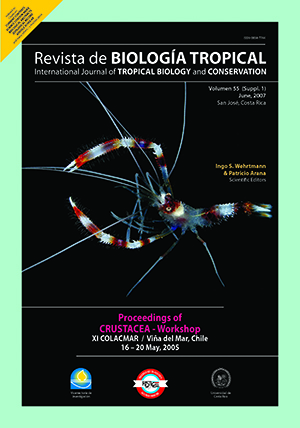Abstract
The green crab Carcinus maenas, a decapod crustacean native to the northeastern Atlantic, has been invading distant areas, mainly for the last 25 years. This species is currently distributed along the coasts of the northeastern Pacific, South Africa, Japan, South Australia, Tasmania, and western and eastern North America, among others. Here we provide information on the biology of the green crab occurring in the central area of San Jorge Gulf, Argentina, where it has been established since 1999-2000. Crabs of both sexes were hand-collected between January 2004 and May 2005 from the intertidal zone and the upper sublittoral fringe. Sex, carapace width and molting stage were recorded. The reproductive status of males was based on the presence of sperm and spermatophores in testes and deferent ducts, and that of females on ovarian development and presence-absence of eggs. Stages of embryonic development for ovigerous females were also recorded. The most important physiological events taking place during the annual cycle of the adult population were as follows: (1) male molt occurred mainly in November and female molt between January and the beginning of March; (2) the reproductive season started in January, after a courtship in which the male, larger in size, holds the female until the molt, and spermatophores are ejaculated once the old exoskeleton is cast off; (3) females left the intertidal zone early and moved to lower littoral levels during fall and winter; (4) larvae appeared in September.##plugins.facebook.comentarios##

This work is licensed under a Creative Commons Attribution 4.0 International License.
Copyright (c) 2007 Revista de Biología Tropical
Downloads
Download data is not yet available.






